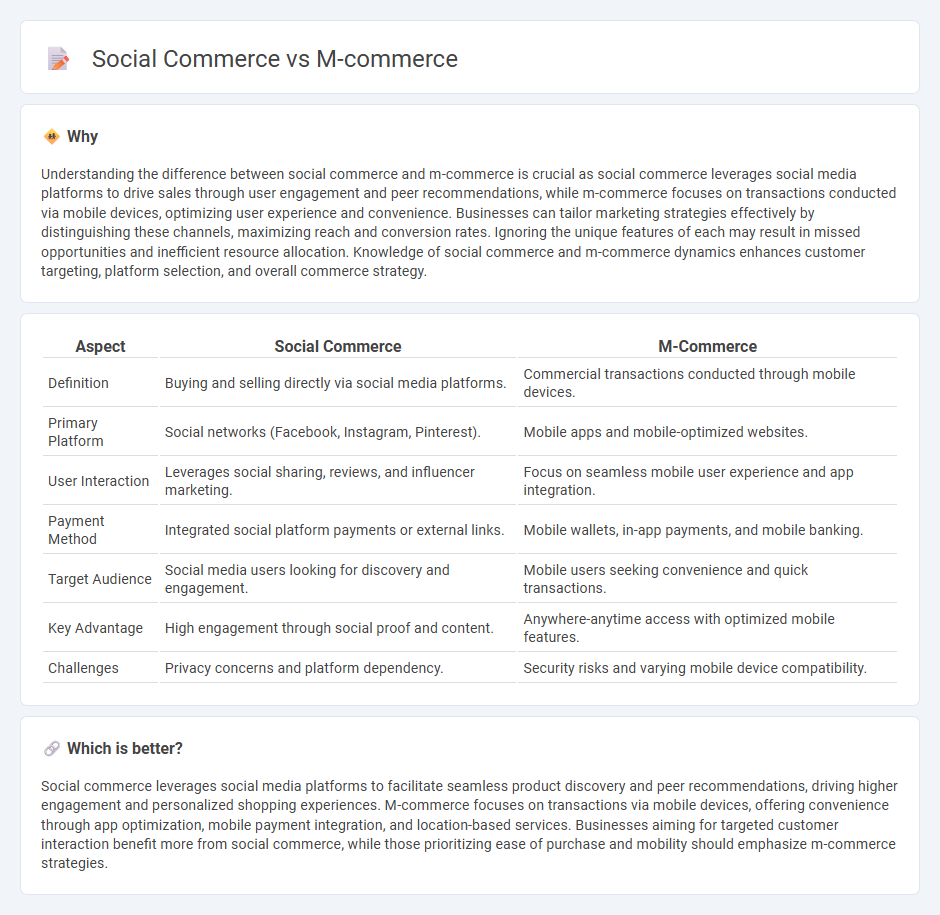
Social commerce integrates e-commerce with social media platforms, enabling users to discover, share, and purchase products directly through social interactions. M-commerce focuses on mobile device transactions, optimizing shopping experiences for smartphones and tablets with features like mobile wallets and app-based purchasing. Explore the key differences and benefits of social commerce versus m-commerce to enhance your digital sales strategy.
Why it is important
Understanding the difference between social commerce and m-commerce is crucial as social commerce leverages social media platforms to drive sales through user engagement and peer recommendations, while m-commerce focuses on transactions conducted via mobile devices, optimizing user experience and convenience. Businesses can tailor marketing strategies effectively by distinguishing these channels, maximizing reach and conversion rates. Ignoring the unique features of each may result in missed opportunities and inefficient resource allocation. Knowledge of social commerce and m-commerce dynamics enhances customer targeting, platform selection, and overall commerce strategy.
Comparison Table
| Aspect | Social Commerce | M-Commerce |
|---|---|---|
| Definition | Buying and selling directly via social media platforms. | Commercial transactions conducted through mobile devices. |
| Primary Platform | Social networks (Facebook, Instagram, Pinterest). | Mobile apps and mobile-optimized websites. |
| User Interaction | Leverages social sharing, reviews, and influencer marketing. | Focus on seamless mobile user experience and app integration. |
| Payment Method | Integrated social platform payments or external links. | Mobile wallets, in-app payments, and mobile banking. |
| Target Audience | Social media users looking for discovery and engagement. | Mobile users seeking convenience and quick transactions. |
| Key Advantage | High engagement through social proof and content. | Anywhere-anytime access with optimized mobile features. |
| Challenges | Privacy concerns and platform dependency. | Security risks and varying mobile device compatibility. |
Which is better?
Social commerce leverages social media platforms to facilitate seamless product discovery and peer recommendations, driving higher engagement and personalized shopping experiences. M-commerce focuses on transactions via mobile devices, offering convenience through app optimization, mobile payment integration, and location-based services. Businesses aiming for targeted customer interaction benefit more from social commerce, while those prioritizing ease of purchase and mobility should emphasize m-commerce strategies.
Connection
Social commerce integrates shopping experiences directly within social media platforms, leveraging user engagement and social interactions to drive sales. M-commerce, or mobile commerce, facilitates these transactions through mobile devices, allowing consumers to browse, purchase, and share products conveniently on smartphones and tablets. The synergy between social commerce and m-commerce enhances customer accessibility, personalized marketing, and seamless payment processes, boosting overall e-commerce growth.
Key Terms
Mobile Applications (M-Commerce)
M-commerce leverages mobile applications to facilitate seamless shopping experiences, providing features like in-app purchases, personalized recommendations, and secure payment gateways designed for smartphones and tablets. Social commerce integrates shopping directly within social media platforms, combining user-generated content, influencer marketing, and social interactions to drive sales. Explore detailed comparisons and benefits of mobile-centric commerce solutions to optimize your digital sales strategy.
Social Media Platforms (Social Commerce)
Social commerce leverages social media platforms like Facebook, Instagram, and TikTok to enable seamless shopping experiences directly within apps, integrating user-generated content, influencer marketing, and social interactions to boost engagement and trust. M-commerce primarily involves mobile apps and websites designed for mobile devices, focusing on convenience and speed but often lacking the social community features inherent in social commerce. Discover how social commerce transforms buying behaviors by merging social connections with e-commerce in real-time.
Consumer Engagement
M-commerce leverages mobile devices to offer seamless shopping experiences through apps and optimized websites, enhancing consumer engagement via personalized notifications and easy checkout processes. Social commerce integrates shopping directly into social media platforms, fostering engagement through interactive content, user reviews, and social proof that drive purchase decisions. Explore how these distinct yet complementary channels can transform your consumer engagement strategies.
Source and External Links
What is m-commerce vs. e-commerce? - Adjust - M-commerce, short for mobile commerce, refers to commercial transactions conducted via apps or mobile websites, and is considered a subset of e-commerce.
M-Commerce: Applications, Advantages & Disadvantages - Carmatec - M-commerce is buying and selling goods or services through mobile devices, enabling activities like shopping, mobile banking, ticket booking, and digital payments on smartphones and tablets.
The Rise of M-Commerce: Why Mobile is the Future of Online Business - MakeWay - M-commerce is transforming consumer shopping behaviors with mobile devices accounting for 60% of all online browsing by late 2023 and nearly half of e-commerce transactions made via mobile wallets such as Apple Pay and Google Pay.
 dowidth.com
dowidth.com